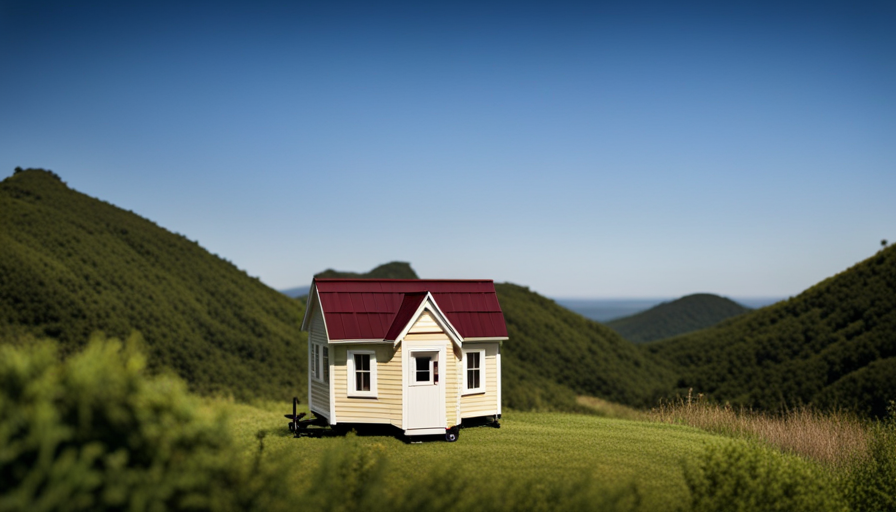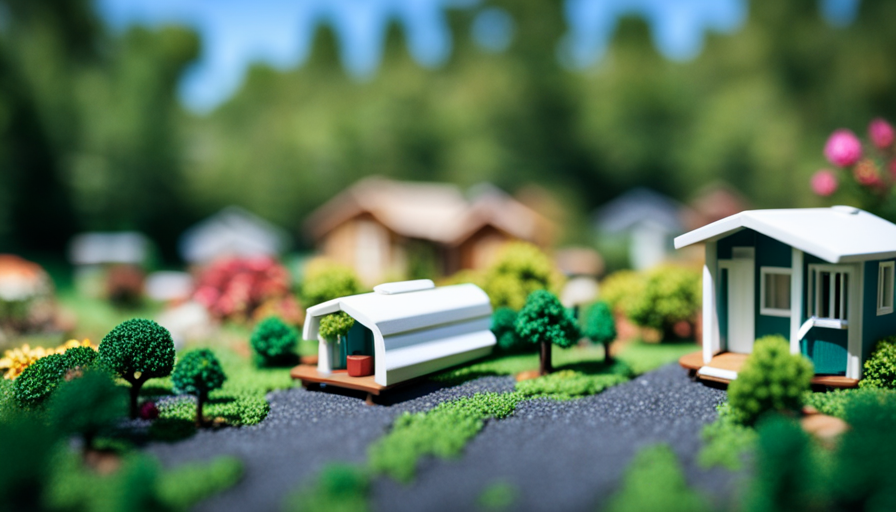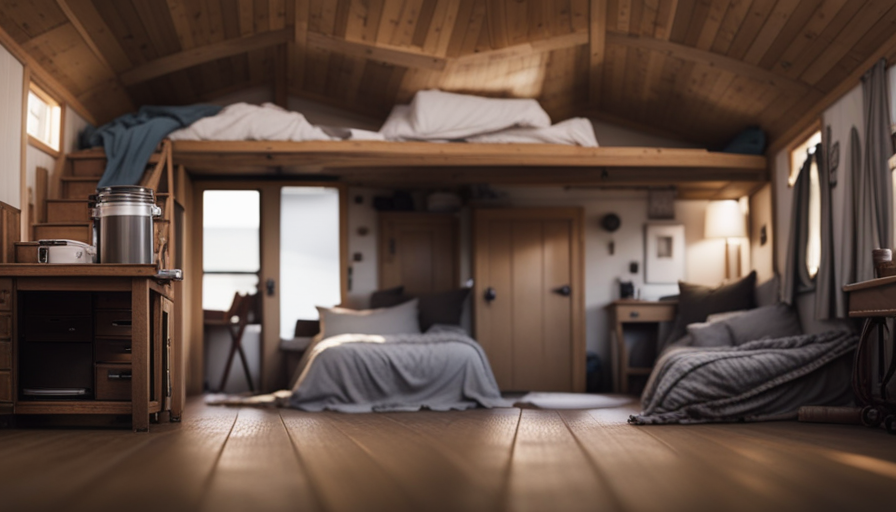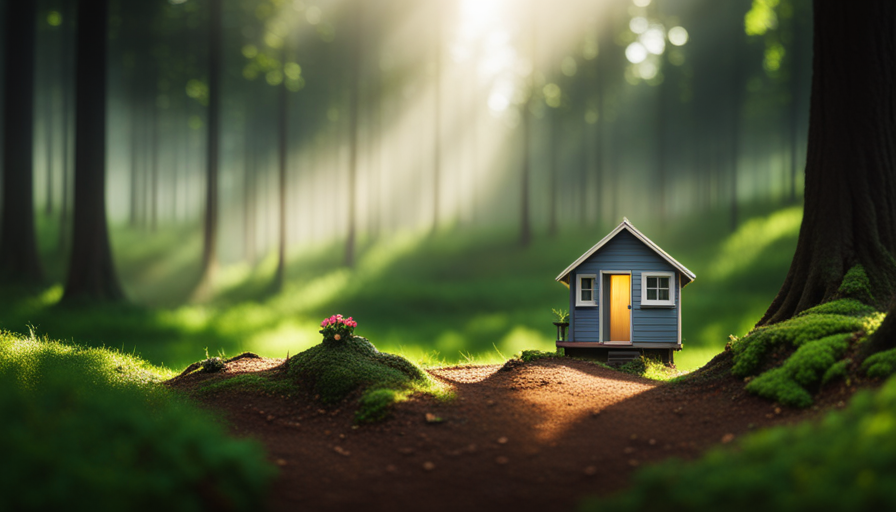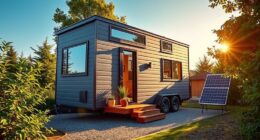As I look up at the looming skyscrapers, their vast height appears to taunt my small mobile home. However, within the small space of my snug refuge, I discover comfort and liberation.
Today, I embark on a quest to unravel the mystery that has long perplexed tiny house enthusiasts like myself – how high can we build our mobile havens? In this article, we will delve into the intricacies of transportation regulations, structural considerations, interior design, accessibility, safety, utilities, and environmental impact.
Additionally, we will explore the labyrinth of local zoning and building codes that dictate the limits of our vertical aspirations. Through captivating case studies and awe-inspiring inspirations, we will unlock the secrets to reaching new heights with our tiny abodes.
Moreover, we will challenge conventional notions by considering alternative options that push the boundaries of mobility and innovation. So, brace yourself for a journey that will elevate your understanding of what it truly means to build a tiny house on wheels.
Key Takeaways
- Transportation regulations and permits are important considerations when building a tall tiny house on wheels.
- Structural considerations such as a sturdy trailer foundation and lightweight materials are necessary to ensure the integrity of the tall structure.
- Maximizing space optimization and clever storage solutions are essential for interior design in taller tiny houses on wheels.
- Balancing height with budget and cost considerations is crucial to ensure the project remains feasible.
Understanding Transportation Regulations
You’ll need to be aware of transportation regulations to avoid any legal complications when hauling your tiny house on wheels, but don’t let that discourage you from taking your dream home on the road! Understanding transportation logistics is crucial to ensure a smooth journey for your tiny house.
One of the key factors to consider is weight restrictions. Each state and country may have different limits on how much weight can be transported on their roads. It’s essential to check these regulations beforehand and make sure your tiny house complies with them. Additionally, you should consider the weight of your towing vehicle and ensure it’s capable of safely pulling the load.
Apart from weight restrictions, there are other transportation logistics to consider. Some regions may require permits for oversized loads, so it’s important to research and obtain the necessary documentation before you hit the road. You may also need to plan your route carefully, taking into account any low bridges, narrow roads, or weight-restricted areas that could pose challenges during transportation.
Understanding transportation regulations is just the first step in successfully hauling your tiny house on wheels. Once you have a grasp of the logistics, you can move on to considering the structural aspects of your tiny house, ensuring it’s built to withstand the stresses of transportation.
Structural Considerations
Imagine the thrill of designing and constructing a compact mobile dwelling, carefully considering the structural aspects to ensure stability and safety throughout its vertical expansion. When it comes to building a tiny house on wheels, structural stability and weight distribution are crucial factors to consider.
Here are three key considerations for ensuring a sturdy and safe structure:
-
Foundation: The foundation of a tiny house on wheels is typically a heavy-duty trailer. It’s important to choose a trailer that can support the weight of the house and distribute the load evenly. Reinforcing the trailer with additional supports and bracing can also enhance its structural stability.
-
Framing: The framing of the tiny house should be designed to handle the stresses of being on the move. Using strong and lightweight materials such as steel or aluminum can help reduce the overall weight while maintaining structural integrity. Proper bracing and connections are essential to ensure the stability of the structure during transportation.
-
Roof and Walls: The roof and walls of a tiny house on wheels should be designed to withstand wind forces and provide adequate insulation. Reinforcing the roof with trusses or rafters and using sturdy materials such as metal or composite panels can enhance its structural stability. Additionally, incorporating proper insulation and moisture barrier systems can help maintain a comfortable and durable interior.
Considering these structural considerations, we can now transition into discussing the next step: interior design and layout.
Interior Design and Layout
Once the structural considerations are in place, it’s fascinating to explore the creative possibilities of designing and arranging the interior spaces of a tiny mobile dwelling, with the average tiny house having only around 200 square feet of livable area. Design trends in the tiny house movement focus on maximizing space optimization and creating a functional yet visually appealing living environment.
In order to make the most of the limited square footage, interior designers often employ clever storage solutions and multipurpose furniture. For example, a table that can be folded against the wall when not in use or a bed with built-in drawers for extra storage. Additionally, utilizing vertical space by installing shelves or cabinets that reach up to the ceiling helps to create more storage options.
To demonstrate various design possibilities, here is a table showcasing three different layout options for a tiny house on wheels:
| Layout Option | Bedroom | Kitchen | Living Area | Bathroom |
|---|---|---|---|---|
| Option 1 | 1 | 1 | 0 | 1 |
| Option 2 | 0 | 1 | 1 | 1 |
| Option 3 | 1 | 0 | 1 | 0 |
As you can see, there are multiple ways to configure the interior based on individual preferences and needs.
Considering the importance of accessibility and safety, the next section will delve into these aspects without compromising on design and functionality.
Accessibility and Safety
Designing a tiny mobile dwelling requires prioritizing accessibility and safety while still maintaining a functional and visually appealing living space. When it comes to accessibility for people with disabilities, there are several important considerations to keep in mind.
Firstly, the entrance to the tiny house should have a ramp or a lift to ensure easy access for individuals with mobility challenges. Additionally, doorways and hallways should be wide enough to accommodate wheelchairs and other assistive devices. It is also crucial to have an accessible bathroom with grab bars and a roll-in shower.
In terms of fire safety measures, it’s essential to install smoke detectors and fire extinguishers in strategic locations throughout the tiny house. Additionally, it’s advisable to use fire-resistant materials for the construction of the dwelling, such as fire-rated insulation and non-combustible wall coverings. Proper ventilation is also crucial to prevent the buildup of toxic gases in the event of a fire.
Ensuring accessibility and safety in a tiny house on wheels requires careful planning and attention to detail. By incorporating these considerations, individuals can create a mobile dwelling that’s not only visually appealing but also functional and safe for all occupants.
Transitioning into the subsequent section about ‘utilities and infrastructure,’ it’s important to address the necessary systems and infrastructure required for comfortable living in a tiny mobile dwelling.
Utilities and Infrastructure
To ensure a comfortable living experience in your compact mobile dwelling, it is vital to consider the necessary utilities and infrastructure. One of the most popular and sustainable options for powering a tiny house on wheels is solar power. By installing solar panels on the roof, you can harness the energy from the sun and convert it into electricity to power your appliances and lighting. This not only reduces your reliance on the grid but also helps you save on energy costs in the long run.
In addition to solar power, another important consideration is water storage. Since tiny houses on wheels often lack a direct water connection, it is essential to have a reliable system for storing and accessing water. This can be achieved through the installation of water tanks or containers underneath the tiny house. These tanks can be filled up when connected to a water source and then used as needed for cooking, cleaning, and bathing.
To summarize, incorporating solar power and water storage systems into your tiny house on wheels is crucial for a self-sufficient and sustainable living experience. These systems allow you to generate your own electricity and store water, reducing your reliance on external resources. In the next section, we will explore the cost and budgeting considerations for building a tiny house on wheels.
Cost and Budgeting
When considering the cost and budgeting of taller tiny houses on wheels, it’s important to take into account the additional expenses that come with increased height.
These expenses may include engineering and structural modifications to ensure the safety and stability of the structure.
Balancing the desired height with the overall project budget is crucial, as taller structures often require more materials and labor, which can significantly impact the total cost of the project.
Therefore, careful planning and consideration of these factors are essential for a successful and cost-effective construction process.
Additional expenses for taller structures
Although it may come with some extra costs, going for a taller tiny house on wheels can lead to a more expansive living space.
However, it is important to consider transportation limitations and construction permits when building a taller structure. The increased height of the tiny house can pose challenges during transportation, as there may be restrictions on the maximum height allowed on roads. This could require additional measures such as removing or lowering certain features to meet regulations.
Additionally, obtaining construction permits for a taller tiny house can be more complex and time-consuming. It may involve additional inspections and documentation to ensure compliance with building codes.
Balancing height with the overall project budget is crucial to avoid exceeding financial constraints, but it can result in a more spacious and comfortable living environment.
Balancing height with overall project budget
Finding the right balance between height and budget is essential for creating a tiny house that not only fits your needs but also provides a spacious and comfortable living environment. When considering the height of your tiny house, it’s important to balance aesthetics with practicality.
Higher ceilings can create a sense of openness and maximize square footage, but they also require additional materials and construction costs. To strike the right balance, consider these factors:
-
Functional needs: Determine the minimum height required for comfortable movement and furniture placement.
-
Structural integrity: Ensure that the height increase won’t compromise the stability of the house.
-
Budget constraints: Evaluate the additional expenses associated with taller structures, such as increased material costs.
By carefully considering these factors, you can find the optimal height for your tiny house while balancing aesthetics and maximizing square footage. Transitioning into the next section about environmental impact, it’s important to also consider the sustainability of your construction choices.
Environmental Impact
The environmental impact of building a tiny house on wheels can be minimized through the use of green building practices and sustainable materials. When constructing a tiny house, it’s important to consider the materials used, as well as the energy efficiency of the design.
Sustainable materials, such as reclaimed wood, recycled insulation, and low VOC (volatile organic compound) paints, can be used to reduce the carbon footprint of the project. Additionally, energy-efficient design features, such as high-quality insulation, LED lighting, and energy-saving appliances, can help to minimize energy consumption.
Incorporating renewable energy sources, such as solar panels or wind turbines, can further reduce the environmental impact of a tiny house on wheels. These systems can provide clean and sustainable energy, reducing reliance on fossil fuels.
By implementing green building practices and using sustainable materials, the environmental impact of a tiny house on wheels can be significantly reduced. This not only benefits the planet by conserving resources and reducing carbon emissions, but it also creates a healthier living environment for the occupants.
Transitioning to the subsequent section about local zoning and building codes, it’s important to consider how these regulations may impact the design and construction of a tiny house on wheels.
Local Zoning and Building Codes
Navigating the maze of local zoning and building codes can be a challenge when it comes to designing and constructing a compact mobile home. Understanding legal restrictions and overcoming height limitations are crucial in order to build a tiny house on wheels that complies with the regulations of the area.
To help you better understand the complexities involved, here is a table summarizing some common local zoning and building code restrictions for tiny houses on wheels:
| Municipality | Maximum Height Limit (in feet) | Minimum Setback Requirements (in feet) | Minimum Lot Size (in square feet) |
|---|---|---|---|
| City A | 13 | 5 | 1,500 |
| City B | 10 | 10 | 2,000 |
| City C | 15 | 8 | 1,200 |
These restrictions vary from one municipality to another, and it is essential to research and understand the specific regulations in your desired location. Once you have a clear understanding of the limitations, you can then work on designing a tiny house that meets these requirements while still maximizing the available space.
Case studies and inspirations from successful tiny house projects can provide valuable insights into how others have creatively overcome these challenges. By studying their approaches, you can gain inspiration and ideas to inform your own design and construction process.
Case Studies and Inspirations
In this discussion, I’ll explore the fascinating world of high-rise tiny houses. I’ll showcase examples of successful projects that have pushed the boundaries of small living. These remarkable structures demonstrate innovative designs and architectural solutions that maximize space and functionality. From clever multi-level layouts to creative use of materials, these case studies provide valuable inspiration for those seeking to design their own compact, yet comfortable, living spaces.
Examples of successful high-rise tiny houses
Imagine yourself living in a tiny house on wheels that soars high above the city skyline, defying expectations and showcasing the endless possibilities of vertical living. Successful high-rise tiny houses have proven that vertical space optimization isn’t only achievable but also highly desirable. These designs maximize every inch of usable space, utilizing innovative solutions to create a comfortable and functional living environment.
The first sub-list emphasizes the importance of vertical storage solutions:
- Custom-built shelving units that utilize the full height of the tiny house.
- Retractable stairs that double as storage compartments.
The second sub-list highlights the significance of efficient furniture design:
- Foldable tables and chairs that can be easily tucked away when not in use.
- Multipurpose furniture pieces, such as sofa beds and hidden storage compartments.
These successful high-rise tiny houses have paved the way for innovative designs and architectural solutions that continue to push the boundaries of vertical living.
Innovative designs and architectural solutions
With innovative designs and architectural solutions, these tiny homes redefine urban living, leaving you in awe of their ingenuity.
Overcoming architectural challenges, these high-rise tiny houses maximize space optimization to create a comfortable and functional living environment. One example is the use of vertical space through multi-level designs and loft areas. By incorporating clever storage solutions and efficient layouts, these homes make the most of every square inch.
Additionally, some innovative designs include retractable furniture, such as fold-away beds and tables, which can be stowed to create more open space when not in use. Furthermore, creative use of windows and skylights allows for ample natural light to flood the interior, giving a sense of spaciousness.
Considering alternative options, these tiny homes provide a glimpse into a future where urban living is reimagined.
Considering Alternative Options
When considering alternative options for tiny house living, two key points to explore are rooftop gardens and outdoor living spaces, as well as other alternatives for vertical living.
Rooftop gardens provide a unique opportunity to maximize space and create a sustainable environment by growing plants and vegetables.
Additionally, exploring other tiny house alternatives for vertical living allows for creative solutions that can maximize space and provide a comfortable living experience.
Both options offer unique benefits and should be carefully considered when designing a tiny house on wheels.
Rooftop gardens and outdoor living spaces
As you step onto the rooftop of your tiny house on wheels, your heart races with anticipation of the lush oasis that’s waiting for you. The concept of rooftop farming isn’t just a practical solution for maximizing outdoor space in a tiny house, but it also adds a touch of natural beauty to your dwelling.
Here’s a detailed picture of what you can expect:
-
Sub-list 1: Rooftop farming:
- Utilize raised beds for growing vegetables and herbs.
- Install a drip irrigation system to ensure optimal water usage.
-
Sub-list 2: Maximizing outdoor space:
- Create a cozy seating area with weather-resistant furniture.
- Install a retractable awning for shade during hot summer days.
By incorporating these strategies, you can transform your tiny house rooftop into a thriving garden and a comfortable outdoor living space.
Transitioning into exploring other tiny house alternatives for vertical living, let’s delve into the possibilities of multi-story tiny homes that maximize space without compromising comfort.
Exploring other tiny house alternatives for vertical living
Delve into the exciting possibilities of vertical living with alternative tiny house options that maximize space and offer a heightened sense of comfort.
When it comes to tiny house alternatives for vertical living, there are a few innovative options worth exploring. One such option is vertical gardening, which allows you to grow plants and vegetables vertically, saving valuable floor space. By utilizing wall-mounted planters and vertical hanging systems, you can create a lush and vibrant green space within your tiny house.
Another alternative is compact furniture, designed specifically for tiny spaces. These pieces are multifunctional and cleverly designed to maximize every inch of available space. From convertible sofas that transform into beds to foldable dining tables, compact furniture offers both practicality and versatility.
With these alternative tiny house options, you can create a vertical living space that is both efficient and comfortable.
Frequently Asked Questions
Is it legal to live in a tiny house on wheels full-time?
Living in a tiny house on wheels full-time is subject to tiny house regulations and zoning laws, which vary depending on location. According to a survey by the Tiny House Society, approximately 63% of cities in the United States have no specific regulations for tiny houses on wheels.
However, it’s important to research and comply with local laws to ensure legality. Zoning laws often dictate where and for how long you can park or reside in a tiny house on wheels.
How do you secure a tiny house on wheels for transportation?
To secure a tiny house on wheels for transportation and ensure safety, there are several key steps to follow.
First, use heavy-duty tie-down straps to secure the house to the trailer.
Install additional braces and supports to reinforce the structure.
Check that all windows, doors, and cabinets are securely closed and latched.
Use wheel chocks to prevent movement during transit.
Finally, inspect the trailer and hitch to ensure they’re in good condition and properly connected.
Are there any specific insurance requirements for a tiny house on wheels?
There are specific insurance requirements for a tiny house on wheels. It’s necessary to have insurance coverage that protects the structure and contents of the tiny house. This includes coverage for damage caused by accidents, natural disasters, theft, and liability. Insurance providers may also require proof of safety features such as smoke detectors and fire extinguishers.
Additionally, if you’re financing your tiny house, the lender may require you to have insurance as part of the loan agreement.
Can you park a tiny house on wheels anywhere or are there restrictions?
Parking a tiny house on wheels is subject to parking regulations and zoning restrictions. These regulations dictate where you can legally park your tiny house. Just as a bird needs a specific branch to perch on, your tiny house needs a designated area for parking.
Before settling, it’s crucial to research local parking regulations and zoning restrictions to ensure compliance. This will help you find the perfect spot to nestle your tiny house and avoid any legal complications.
What are the limitations on the size and weight of a tiny house on wheels for transportation purposes?
For transportation purposes, there are limitations on the size and weight of a tiny house on wheels. Building codes dictate the maximum dimensions and weight allowances to ensure structural integrity during transportation.
These codes vary depending on the jurisdiction, but generally, tiny houses on wheels should not exceed certain height, width, and weight limits. Adhering to these regulations is crucial to ensure safe and legal transportation of the tiny house on wheels.
Conclusion
In conclusion, building a tiny house on wheels requires careful attention to transportation regulations, structural considerations, interior design and layout, accessibility and safety, utilities and infrastructure, environmental impact, and local zoning and building codes.
By incorporating these factors, individuals can create a sophisticated and efficient living space that maximizes the use of limited space.
The possibilities are endless, and with a touch of creativity, a tiny house on wheels can reach heights of innovation that’ll leave a lasting impression on anyone who sees it.
Hi, I’m Emma. I’m the Editor in Chief of Tiny House 43, a blog all about tiny houses. While tree houses are often associated with childhood, they can be the perfect adult retreat. They offer a cozy space to relax and unwind, surrounded by nature. And since they’re typically built on stilts or raised platforms, they offer stunning views that traditional homes simply can’t match. If you’re looking for a unique and romantic getaway, a tree house tiny house might just be the perfect option.
